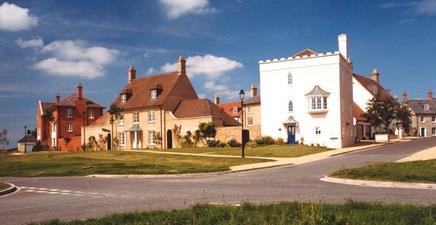Village masterplan dropped in wake of concerns over local development framework
Prince Charles’ grand plan tobuild a “green Poundbury” has been scuppered by a planning wrangle over the site.
The Duchy of Cornwall office has spent 10 years and about £2m developing his vision of an eco-friendly, traditionally-designed model village, a little brother to Poundbury in Dorset.
But proposals for 850 homes on a 100ha site to the east of Newquay in Cornwall, dubbed “Surfbury” by local people, are now in doubt as the overall masterplan for the development has not been given planning permission.
The prince’s vision was set to be secured by a supplementary planning guidance (SPG) document, which would dictate the quality of design and workmanship, as well as the sustainability of the buildings and how energy would be generated for the entire site.
But an SPG can only be secured if a council has a local development framework (LDF), which sets out what construction will take place in the area. Restormel council, the local authority for Surfbury, has had its LDF rejected by the planning inspector and the government.
A spokesperson for Duchy of Cornwall said: “The larger masterplan is effectively on hold while the local authority resolves its issues with the planning inspectorate.”
Having overall control of the site is crucial for the prince to realise his vision. The success of Poundbury hinged on the masterplan drawn up by architect Leon Krier, also the brains behind this scheme. Another Poundbury veteran, architect Robert Adam, has drawn up a building code to be implemented across Surfbury.
Prince Charles owns about two-thirds of the site and can implement his vision there, but his relations with the other landowners are already strained following disagreements over what infrastructure, such as roads and utilities, are needed for the site and who will pay for them.
Tony Lee, head of planning at Restormel council, said each housing scheme on the site would have to be submitted for planning separately. “The process is so mired in red tape that sometimes I feel we will never get anything built,” he said. “We couldn’t impose a masterplan on the whole development. There are several other landowners and only one has agreed to sign up to the same standards so far. There are two or three whose intentions we don’t know.”
Last month, the Duchy of Cornwall submitted plans for the first phase of Surfbury, which includes up to 300 homes on Duchy land. At least 30% of the homes would be affordable. There is no date for the second phase.
Restormel and the government are now in a deadlock over the LDF. Surfbury had already been on hold for two years while the framework was being drawn up and a new document will take at least another two years to write. To add to the complication, Restormel council is set to be merged into a unitary authority in 18 months’ time and would need a new LDF.
The government’s insistence on each local authority drawing up an LDF has caused huge delays in delivery. David Lock, managing director of David Lock Associates, said 94% of councils did not yet have an LDF in place, as the government had rejected them or the council had found it too complicated to draw up. The LDF system came into force in September 2004 and the documents were supposed to take three years to draw up.
Designer Wayne Hemingway, who teamed up with housebuilder George Wimpey after criticising its work, is about to embark on his own housebuilding enterprise. Hemingway said he would take a shareholding in a joint venture that will develop four regeneration sites.
He added that he was no longer working on two schemes for Taylor Wimpey following disagreements on design. He is still working with the housebuilder on other schemes, however.
The Prince’s vision
- 850 homes on a 100 hectare site
- Carbon dioxide reduction of at least 20% from onsite renewables including CHP boiler and community wind turbine
- 30% or more improvement on Part L 2006, rising to 60% beyond 2010
- jobs for 850 people
- new primary school as well as shops, offices and community facilities
- integrated private and affordable housing
- construction materials sourced locally to reduce embodied carbon emissions
- new primary school as well as shops, offices and community facilities
- a walkable neighbourhood, with reliance on public transport
Source
RegenerateLive






















No comments yet